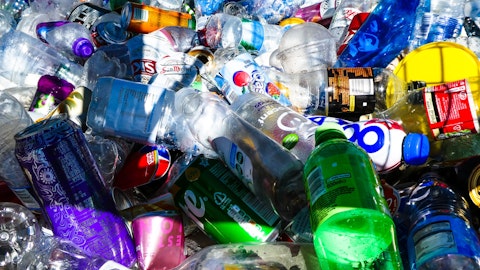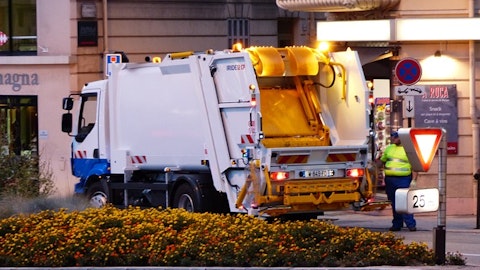Quest Resource Holding Corporation (NASDAQ:QRHC) Q4 2022 Earnings Call Transcript March 23, 2023
Operator: Thank you for standing by. This is the conference operator. Welcome to the Quest Resource Holding Corporation Fourth Quarter 2022 Earnings Conference Call. . I would now like to turn the conference over to Dave Mossberg, Investor Relations representative. Please go ahead.
David Mossberg: Thank you, Brenda, and thank you, everyone, for joining us on the call. Before we begin, I’d like to remind everyone that this conference call may contain predictions, estimates and other forward-looking statements regarding future events or future performance of Quest. Use of words like anticipate, project, estimate, expect, intend, believe and other similar expressions are intended to identify those forward-looking statements. Such forward-looking statements are based on Quest’s current expectations, estimates, projections, beliefs and assumptions and involve significant risks and uncertainties. Actual events or Quest’s results could differ materially from those discussed in the forward-looking statements as a result of various factors, which are discussed in greater detail in Quest’s filings with the Securities and Exchange Commission.
You are cautioned not to place undue reliance on such statements and to consult our SEC filings for additional risks and uncertainties. Quest’s forward-looking statements are presented as of the date made, and we disclaim any duty to update such statements unless required to do so by law. In addition, in this call, we may include industry and market data and other statistical information as well as Quest’s observations and views about industry conditions and developments. The data and information are based on Quest’s estimates, independent publications, government publications and reports by market research firms and other sources. Although Quest believes these sources are reliable and the data and other information are accurate, we caution that Quest has not independently verified the reliability of the sources or the accuracy of the information.
Certain non-GAAP financial measures will also be discussed during this call. These non-GAAP measures are used by management to make strategic decisions, forecast future results and evaluate the company’s current performance. Management believes the presentation of these non-GAAP financial measures is useful to investors understanding the assessment of the company’s ongoing core operations and prospects for the future. Unless it is otherwise stated, it should be assumed that any financials discussed in this call will be on a non-GAAP basis. Full reconciliation of non-GAAP to GAAP financial measures are included in today’s earnings release. With all that said, I’ll now turn the call over to Ray Hatch, President and Chief Executive Officer.
Ray Hatch: Thank you, Dave, and thanks, everyone, for your interest in Quest. Overall, we had a strong year in 2022 with 70% growth in gross profit dollars. We managed through tremendous growth during the year, expanding relationships with existing customers and a significant ramp from new customers. Growth also came from integrating 4 acquisitions during 2022. Three of these acquisitions have gone according to plan, but the fourth, RWS, caused challenges for us during this past year. It is a good business with a strong customer base, but process issues hampered the performance. The good news is that we’ve addressed the RWS issues, and we’ve already begun to see substantial improvements from that acquisition thus far in the first quarter and expect to fully realize the planned contribution through 2023.
Outside of RWS, our business performed well. We are executing well on all of our strategies, we continue to move new opportunities through our pipeline. We continue to build our operating platform, investing in capabilities, which will enable us to drive operating efficiencies, integrate acquisitions more quickly and to continually enhance our customer service. Importantly, our outlook for profitable growth in 2023 and beyond remains unchanged. Because RWS has such a large impact on the fourth quarter and the year, before I turn the call over to Brett to review financials, I’m going to give you an update on what’s going on there and an overview of the corrective actions we’ve taken. To give you a little background, we made the RWS acquisition at the end of 2021.
This was the largest acquisition that we have made to date, and we decided to integrate the business over a longer time period. The plan was to pursue cross-selling opportunities and implement Quest business processes at RWS, then wait to fully integrate until we have more time to operate the business. The thinking was that this would allow us to achieve the highest contribution of the acquisition while, at the same time, to avoid disrupting the business. In retrospect, waiting to fully integrate RWS quickly was a mistake which caused 2 major issues. First, because of the information gaps in RWS, it was challenging to implement our vendor optimization processes there, which entails working with vendors in areas such as volume pricing, rightsizing and route optimization.
Second, our normal process of passing through contracted cost increases and fuel surcharges was not being done with a subset of the RWS customers. We estimate these factors combined to reduce gross profit dollars by approximately $1.5 million for 2022. We’ve implemented Quest best practice across RWS business and have realigned management reporting structure for each department. Our accounting, operation, sales and marketing groups are now fully integrated as of the end of the year, and we expect systems integrations to be completed during the third quarter. We’ve corrected the process to pass through costs and fuel surcharges that are part of the contractual agreements at RWS. While we can’t bill and catch up for past periods, we started to see benefits of implementing pass-through costs and fuel surcharges to RWS customers starting in January.
We’ve addressed information gaps and implemented vendor management improvements. We are seeing the benefits in the first quarter and expect to see improvements in gross profit throughout the year. Along with the continued strength of our core business, the corrective actions we have taken have already begun to result in incremental improvement during the first quarter. As we said in the press release, the trajectory is positive. Preliminary results for January and February showed gross profits averaging approximately $4.25 million per month and revenue averaging $24 million per month, with further improvement expected across the remainder of the year. While expected contribution from RWS was delayed, I want to reiterate that our view of the potential of the business and our original financial expectations remain intact.
It’s important to note that customer relationships remain strong. And in fact, we’ve been able to successfully cross-sell RWS services to existing Quest clients. Equally important, we’ve also maintained or improved relationships with RWS vendors. I’ll now turn the call over to our CFO, Brett Johnston, for our financial overview, and I’ll be back to discuss tranches. Brett?
Brett Johnston: Thanks, Ray, and good afternoon, everyone. We had mixed results during the fourth quarter, with solid performance in our core business being offset by integration challenges at RWS. A quick note about the sequential decrease in revenue, it was primarily related to commodity price fluctuations and normal fourth quarter seasonality. As discussed on previous calls, commodity price fluctuations have not historically had material effects on gross profit dollars. Our customer agreements produce consistent gross profit dollars based on volumes that are not tied to commodity price fluctuations. The value of the commodities we recycle on behalf of our clients simply passes through to our P&L. During the fourth quarter, gross profit dollars increased 25% year-over-year to $10.8 million.
And for the year 2022, gross profit dollars increased 70% to $48.9 million. For the quarter, we estimate that approximately 1/3 of the increase in gross profit dollars came from acquisitions and the remaining 2/3 from organic growth. Of the organic growth for the quarter, the bulk was driven by new customer growth. For the year, we estimate that approximately 2/3 of the increase in gross profit dollars came from acquisitions and the remaining 1/3 from organic growth. Of the organic growth for the year, the bulk was also driven by new customer growth. As we have previously stated, due to the ongoing integration work and resulting accounting adjustments, it was difficult to make sequential comparison in gross profit dollars from quarter-to-quarter during 2022.

Photo by David East on Unsplash
However, as Ray mentioned earlier, we feel significant progress has been made with the acquisition of RWS, and these accounting adjustments were finalized during 2022. As Ray said earlier, we estimate that the issues with RWS reduced gross profit dollars during 2022 by approximately $1.5 million. As a reminder, this was related to slower-than-expected implementation of contract optimization processes and missing price adjustments with certain RWS customers that we normally take as part of our contracted agreements. Outside of RWS, I want to note that sequential gross profit dollar comparisons were not affected by inflationary cost pressures. We were able to offset inflationary cost pressure with flexible pricing and cost recovery fees. We have implemented changes at RWS and expect these changes will be in full effect by the end of the second quarter.
Looking forward, our outlook for gross profit dollars for the year is robust, and we remain confident in our ability to deliver double-digit growth in gross profit dollars during 2023. Gross profit dollars should benefit from continued momentum in organic growth and continued improvement from our integration efforts. Moving on to SG&A expenses, which were $9.8 million during the fourth quarter compared to $7.1 million during the same period last year. The increase in the comparison was mostly related to overhead from acquired businesses. For the quarter, SG&A was a little higher than our expectations of $9.1 million to $9.5 million, which was mostly related to additional bad debt reserves and increased integration costs. During the first quarter of 2023, we expect SG&A costs will be about $9.5 million to $10 million, which reflects the ongoing run rate of our business, along with the ongoing acquisition and integration costs, and increased investment in systems, processes and people to continuously improve our efficiency and the scalability of our platform.
During the fourth quarter, depreciation and amortization increased to $2.4 million versus $1.2 million a year ago. The increase was primarily related to amortization of acquisition of intangibles. We expect depreciation and amortization to be approximately $10 million for 2023. Moving on to a review of the cash flow and balance sheet. We are in good shape liquidity-wise. Our cash balance was $9.6 million, which increased from $8.4 million at the beginning of the year. In December, we enhanced our liquidity by increasing the size of the operating borrowing line from $15 million to $25 million. We generated approximately $1.1 million in operating cash flow during the fourth quarter. For the year, we used $2.3 million in operating cash flow. The use of cash was primarily related to investment in working capital to support nearly doubling the size of our company year-over-year.
During 2022, CapEx was $1.7 million, and we utilized approximately $2.6 million in cash to purchase a smaller acquisition during the first quarter. We expect a slight increase in CapEx to approximately $2 million during 2023, which includes increased investment in our operating platform. At the end of the quarter, we had $74.9 million in notes payable versus $67.9 million at the beginning of the year. That increase reflects the investments in growth we made during 2022. At this time, I’ll turn the call back to Ray.
Ray Hatch: Thank you, Brett. While we’re not happy with the integration process of RWS, I want to reiterate that this 1 quarter does not affect our overall outlook for the company and it does not reflect on the tremendous growth progress that the company has made during the last several years and our opportunity for continued double-digit growth. I’m very proud of the track record that our team has produced, nearly doubling the size of the company in 2022, but this past year marking 6 consecutive years of double-digit growth in EBITDA. I want to reiterate that the issues we have with RWS were very specific in nature. And they’ve been addressed and we are beginning to realize the strategic benefit of this acquisition. At the time we announced the acquisition of RWS and InStream in December of 21, we expected to add a combined adjusted EBITDA of approximately $5.5 million annually.
While RWS was behind our expectations in ’22, it still delivered positive incremental EBITDA during the year, and InStream is performing in line with our expectations. Our business is strong, and we’re well positioned to continue to weather challenging economic conditions and execute our growth strategies. In a market that continues to see inflationary pressure and significant fall of commodity values and certain recycled materials, our business model held up well. As Brett mentioned earlier, we structured our agreements so that the gross profit dollars are not affected by swings in commodity prices. But despite the significant decrease in prices for scrap metal and other commodities during the second half of ’22, gross profit dollars generated were not significantly affected by those swings.
In an inflationary environment, we’re able to offset cost pressures for flexible contracts that allow us to pass through increasing cost as fuel surcharges. While these costs were not being passed on during 2022 at RWS, in the core business, we continue to successfully pass through costs for our contracts and offset inflationary pressures. Again, going forward, we’ve corrected this issue at RWS. Regarding the economic environment in general, we continue to see stable activity levels across all of our end markets, and our value proposition is resonating with both existing and with new customers. Moving on to a discussion about growth. I feel very good about the organic growth we have in front of us. Within our installed base of customers, we continue to use the land-and-expand strategy to deliver growth.
This strategy has consistently delivered a base of organic growth for the last 5 years. We recently made a slight tweak to our compensation structure of our client service managers, offering them a chance to earn incentive pay based on growing the contribution from existing customers. We made this change in the first quarter of ’23, and it’s been rewarding to see all the excitement level with the entire team. This small investment in incentive compensation will go a long way to increase growth. In addition, we expect these changes to help us retain and attract the best talent and to further align us with our clients’ growth goals, diverting more waste from the landfill. Another key to organic growth from existing customers is adding new services.
We added several new service capabilities with our recent acquisitions, and we’re actively introducing these new services to existing clients. By adding new services and geographies, we feel confident that the existing customers will continue to provide a major contribution to organic growth for the years to come. On top of growth for existing customers, during the last couple of years, we’ve improved new client targeting and are closing on the right new targets. During the fourth quarter, we continued to add new prospects, and several large opportunities across multiple end markets are working their way through our pipeline. Last quarter, we spoke about 2 new 7-figure wins, one in industrial market and one in the automotive service market.
We’re in the early stages of onboarding these customers and expect them to ramp over the course of the next 12 to 18 months. Our data platform, with its ability to provide uniform and supported data sets across multiple waste streams, continues to play a key role in securing new wins and growing within our existing customer base. A good illustration of our value proposition is how quickly we’re able to ramp and provide value for a large new industrial customer during ’22. The Fortune 50 customer was fully onboarded by the end of the fourth quarter and became a 8-figure revenue customer during ’22. We’re now delivering 8,000 lines of service to this customer across all their locations in the U.S. We have a direct feed from our portal to their systems and are providing them not only with important operation data but also data for the sustainability portion of their ESG reports.
To date, we have helped them divert more than 135,000 tons from landfill, and we’ve brought them cost savings. I’m so impressed with the capabilities of our platform and appreciative and proud of the dedication of our team had that was able to ramp this customer so quickly and provide such a strong value proposition. Moving on to a discussion about M&A. We continue to evaluate opportunities, and M&A will continue to be an important part of our growth plans going forward. I want to reiterate that we’ll continue to maintain discipline in making acquisitions. We’ll only execute those that fit our criteria. We’ve made 6 acquisitions since 2020. Other than RWS, all have performed at or above our expectations. And I will reiterate that we expect RWS to be back on track during ’23.
Moving to operating efficiencies. We’ve grown rapidly over the last 3 years, with the size of the business nearly tripling since 2020. We’ve achieved this scale through growth in existing customers, organic growth and by completing 6 acquisitions. We’ve grown into new waste streams and into new end markets, diversifying our customer base and improving our financial strength. Growth has not been linear, but we’ve been driven to continually improve our ability to drive scale and operating efficiencies, more rapidly integrate acquisitions and drive efficiencies throughout the organization, converting gross profit to cash flow and earnings. We’ll continue to invest in the organization and build capabilities to do so. Regarding our outlook, overall, our positive outlook for profitable growth has not changed.
We’ve addressed the issues with RWS and we expect to see continued improvement in the months and quarters to come and expect to achieve our original plan for contribution from RWS during 2023. We expect the acquisition and integration to provide incremental contribution from both increased efficiencies and from cross-selling. We expect continued positive momentum in the core of our business during 2023. Pressure to improve sustainability, increasing regulation, increasing cost of landfills are lowering the bar for adaptation of recycling services. The contribution from new client wins will continue to provide incremental gross profit dollars as we onboard these programs. And we will continue to drive operating efficiencies, investing in capabilities and driving growth in gross profit, cash flow and earnings.
We are optimistic we’ll continue with positive momentum for ’23 and the next several years. I look forward to keeping you updated on our progress. We now like the operator to provide instructions on how listeners can queue up for questions. Operator?
See also 10 High Growth Retail Stocks That Are Profitable and 12 Best Defense Stocks To Buy Now.
Q&A Session
Follow Quest Resource Holding Corp (NASDAQ:QRHC)
Follow Quest Resource Holding Corp (NASDAQ:QRHC)
Operator: . The first question comes from Aaron Spychalla from Craig-Hallum.
Aaron Spychalla: First, maybe on just kind of the sales funnel, sales cycle. Can you talk about how the sales cycle has been trending given the macro and just your value proposition resonating in the market? And then on onboarding, can you talk a little bit about how that’s gone with some of the recent wins? And what are some of the key drivers that you’re focused on there to shorten that process?
Ray Hatch: Yes. Shorten the process is the key phrase, Aaron, thank you for the question. Our pipeline represents a bit of a dichotomy to me. On the one hand, I’m very impressed with the quality of prospects and the moving along the pipeline. On the other hand, I will tell you that I don’t know if the macro is the cause or not, Aaron, but it’s been slow to get them pushed across. I want to reiterate, we’ve got good customers and prospects in there, the type we’re looking for. And we don’t have prospects falling out. Our frustration is that it’s not moving as quickly as we would like. But the good news is we know they will, it’s just taking a little longer to do it. And as far as onboarding goes, that process is something we always push to accelerate.
It’s usually driven by the customers’ ability to digest, putting new locations on. I will say, and I think we mentioned in the prepared remarks, that last large industrial customer we had took a year really to ramp in. And I think in the past, it might have taken 18 months. So I think our ability to digest and move forward is accelerated. The question is how fast can the customers move on, getting new locations up to date on the transition.
Aaron Spychalla: All right. And then maybe on just food waste, we’ve seen numerous states regulating food waste and kind of corporate initiatives around that. Can you just give an update there and kind of what that opportunity might look like for you over time?
Ray Hatch: Yes. Thanks for that, and that’s a good observation. Food waste is getting a lot of, I guess, attention, and rightfully so. One of the largest, if not the largest, group of the type of materials that are going into landfills is organic waste. So it’s a major culprit in filling those things up. So luckily, that area has got a lot of growth. We’re excited about it. Regulation is one of the things that’s feeding it, to your point. And so it’s making our — I guess maybe it helps somebody answer then call sometimes that they may not have taken before from our sales group. So we’ve really gotten some exciting leads and some nice brand names in there that have a lot of active conversations going with us. And a big part of that is educating them as to what the possibilities are for diverting.
But it’s helping us. I’ll be honest with you, I really think the regulation and the press is helping move that forward. And so we’ve added a lot of new prospects. We’re moving down the path. And I’m really excited for this year. I think we’re going to see an accelerated growth in our food waste program adaptation.
Aaron Spychalla: Good, good. We’ll stay tuned for that. That’s it for me. I’ll turn it over.
Operator: The next question comes from Gerard Sweeney from ROTH Capital.
Gerard Sweeney: On the fourth quarter, you described some seasonality, also commodity pricing impacting, I guess, the revenue line. Would you be able to break out how much was seasonality and how much was commodity pricing, by chance?





